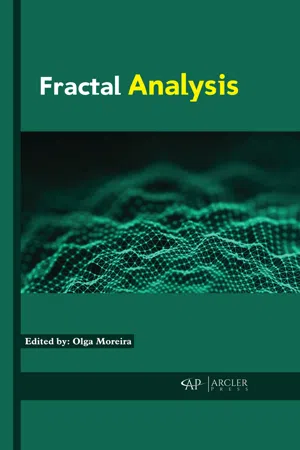Fractal Analysis
About this book
The book "Fractal Analysis" is a collection of contemporaneous articles aims to guide the reader through the world of fractals. A world of computer-generated self-similar patterns that can capture the intricacy of natural structure such as snowflakes, fern leaves, and tree branching. A world that is not only aesthetically pleasing but that is also at the basis of new technologies such as fractal antennas included in every mobile phone. The book is centred on simulation models as well as on the implementation of different methods of measuring the spatial and temporal characteristics of fractal patterns. For instance, box-counting based methods that can be used to determine the fractal dimension of the edges of the Saturn's rings, forested landscapes, brain imaging data, and occurrence of words in text. It also includes an overview of fractal theory concepts, from self-similarity to the complexity of fractal networks.
Frequently asked questions
- Essential is ideal for learners and professionals who enjoy exploring a wide range of subjects. Access the Essential Library with 800,000+ trusted titles and best-sellers across business, personal growth, and the humanities. Includes unlimited reading time and Standard Read Aloud voice.
- Complete: Perfect for advanced learners and researchers needing full, unrestricted access. Unlock 1.4M+ books across hundreds of subjects, including academic and specialized titles. The Complete Plan also includes advanced features like Premium Read Aloud and Research Assistant.
Please note we cannot support devices running on iOS 13 and Android 7 or earlier. Learn more about using the app.
Information
Table of contents
- Cover
- Title Page
- Copyright
- DECLARATION
- ABOUT THE EDITOR
- TABLE OF CONTENTS
- List of Contributors
- List of Abbreviations
- Preface
- Chapter 1 Introduction
- Chapter 2 Definition of Fractal Topography to Essential Understanding of Scale-Invariance
- Chapter 3 Entropy and Fractal Antennas
- Chapter 4 Edges of Saturn’s Rings are Fractal
- Chapter 5 The Fractal Patterns of Words in a Text: A Method for Automatic Keyword Extraction
- Chapter 6 Higuchi Dimension of Digital Images
- Chapter 7 Towards Video Quality Metrics Based on Colour Fractal Geometry
- Chapter 8 Fractal Analysis of Time-Series Data Sets: Methods and Challenges
- Chapter 9 A Tutorial Introduction to Adaptive Fractal Analysis
- Chapter 10 Pitfalls in Fractal Time Series Analysis: fMRI BOLD as an Exemplary Case
- Chapter 11 Characterization of Forested Landscapes from Remotely Sensed Data Using Fractals and Spatial Autocorrelation
- Chapter 12 Application of Fractal Algorithms of Coastline Echo’s Generation on Marine Radar Simulator
- Chapter 13 Three-Dimensional Surface Parameters and Multi-Fractal Spectrum of Corroded Steel
- Chapter 14 Application of the Fractal Geometry Theory on Fracture Network Simulation
- Chapter 15 Drained Rock Volume Around Hydraulic Fractures in Porous Media: Planar Fractures versus Fractal Networks
- Chapter 16 Multifractal Analysis of Weighted Networks by a Modified Sandbox Algorithm
- Chapter 17 Reliable Multi-Fractal Characterization of Weighted Complex Networks: Algorithms and Implications
- Index
- Back Cover
